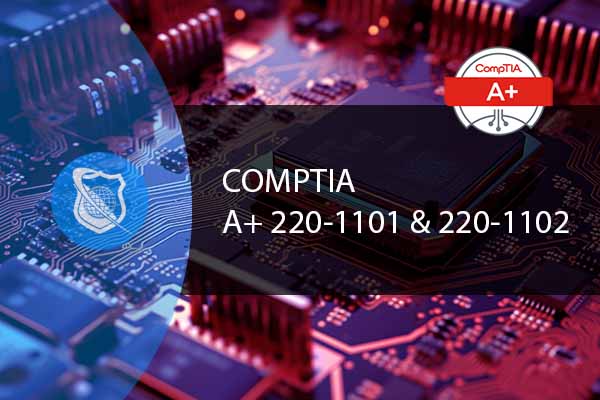Welcome to the third installment of our 9-part series on the CompTIA A+ certification. In this article, we’ll delve deep into the domain of Mobile Devices CompTIA A+, focusing on mobile device hardware, configurations, and troubleshooting. If you’re preparing for the CompTIA A+ exam, this domain is crucial. It covers a wide range of topics that are essential for anyone aspiring to become an IT professional. So, let’s get started by understanding what this domain entails and the critical components that you should pay attention to.
Why Mobile Devices CompTIA A+ Are Important
In today’s digital age, mobile devices have become ubiquitous. They are not just communication tools but also serve as computing devices capable of performing a multitude of tasks. Understanding mobile device hardware and software is a key component of the CompTIA A+ certification. This knowledge is vital for Mobile Device Management and ensuring Mobile Device Security, two areas that are increasingly important in both personal and professional settings.
Mobile Devices CompTIA A+ Domain
| Domain | Description |
|---|---|
| 01 – Hardware | Computer components and troubleshooting |
| 02 – Networking | Networking concepts and troubleshooting |
| 03 – Mobile Devices | Mobile device hardware and troubleshooting |
| 04 – Hardware & Network Troubleshooting | Diagnosing and resolving issues |
| 05 – Operating Systems | OS features, installation, and management |
| 06 – Software Troubleshooting | Common software issues and solutions |
| 07 – Security | Basic security concepts and practices |
| 08 – Virtualization & Cloud | Introduction to virtualization and cloud |
| 09 – Software TroubleshootingOperational Procedures | IT best practices and procedures |

CompTIA A+ Course
Embark on a transformative journey into the world of IT with our CompTIA A+ Certification course. From mastering hardware and network devices to software troubleshooting and security procedures, this comprehensive course equips you with the skills to excel in the ever-evolving tech landscape. Take the next step in your career and prepare for the CompTIA A+ exams!
Understanding Mobile Devices CompTIA A+: The Basics
Types of Mobile Devices
In the realm of CompTIA A+ Hardware, the term Mobile Devices CompTIA A+ encompasses a variety of gadgets, each with its unique set of features and functionalities. Let’s break down the primary types:
- Smartphones: These are the most common mobile devices and serve as the Swiss Army knife of the digital age. They combine the functionalities of a computer, camera, GPS, and traditional phone into one device. Smartphones run on various Mobile Operating Systems like Android, iOS, and others.
- Tablets: Larger than smartphones but smaller than laptops, tablets offer a middle ground for those who want a bigger screen without sacrificing portability. They are excellent for tasks like reading, drawing, and even some lightweight computing tasks.
- Wearable Technology: This category includes smartwatches, fitness trackers, and even smart glasses. These devices often sync with smartphones or tablets and provide quick access to notifications, health metrics, and more.
Understanding the hardware configurations of these devices is crucial for effective Mobile Device Troubleshooting and is a key topic in the CompTIA A+ Study Guide.
Key Hardware Components
To fully grasp the intricacies of mobile device hardware, you need to be familiar with the following key components:
- Processor (CPU): Often referred to as the “brain” of the device, the processor handles all the computations that make the device function. The speed and efficiency of the processor significantly affect the device’s overall performance. In the CompTIA A+ exam, you may encounter questions that require you to identify processor types or troubleshoot processor-related issues.
- Memory: This includes both RAM (Random Access Memory) and ROM (Read-Only Memory). RAM is volatile memory used for temporary storage while the device is on, affecting how fast or slow applications run. ROM is non-volatile and stores the firmware that the device needs to boot up. Understanding memory is essential for Mobile Device Management and is often covered in the CompTIA A+ Resources.
- Battery: The lifeblood of any mobile device, the battery provides the power needed for all components to function. Battery management and troubleshooting are critical skills, especially when dealing with Mobile Device Security features that may consume more power.
- Display: This is the user’s window into the device’s software. Display technology can range from LCD to OLED, each with its pros and cons. Knowing how to troubleshoot common display issues is a valuable skill and is often included in CompTIA A+ Best Practices.
- Connectivity Components: These include various interfaces like Wi-Fi for internet connectivity, Bluetooth for short-range connections, and cellular radios for Mobile Device Networking. Understanding these components is crucial for setting up and maintaining a secure network environment, a topic you’ll likely encounter in your CompTIA A+ Training.
By understanding these hardware components in-depth, you’ll be better prepared for the Mobile Devices CompTIA A+ domain. This knowledge is not just theoretical; it has practical applications in real-world scenarios, making it invaluable for any IT professional.
Mobile Device Configurations: Best Practices
Configuring mobile devices properly is not just a matter of convenience; it’s a necessity for both functionality and security. Here’s how to approach it in line with CompTIA A+ Best Practices for the Mobile Devices CompTIA A+ domain:
Operating System Selection
Choosing the right Mobile Operating System (OS) is the first step in setting up your device. The OS you select will determine the range of apps you can install, the user interface, and even the security features available to you. The major players in this space are Android and iOS, each with its pros and cons. Your choice should align with your specific needs, whether it’s customization, ease of use, or enterprise compatibility.
Security Measures
- Mobile Device Encryption: Encryption converts your data into a code to prevent unauthorized access. This is crucial for protecting sensitive information, especially in a corporate environment. Most modern mobile operating systems offer built-in encryption features that you can enable in the settings.
- Mobile Device VPN: A Virtual Private Network (VPN) provides an extra layer of security when you’re connected to the internet. It encrypts your data and routes it through a secure server, making it difficult for anyone to intercept or track your online activities.
App Management
Managing the apps on your mobile device is crucial for maintaining performance and security. Here are some guidelines:
- Source Verification: Always download apps from trusted sources like Google Play Store or Apple App Store. These platforms have security measures to weed out malicious software.
- App Permissions: Be cautious about the permissions you grant to apps. An app that asks for more permissions than necessary could be a red flag.
- Regular Updates: Keep your apps updated to the latest version to benefit from security patches and new features.

CompTIA A+ Course
Embark on a transformative journey into the world of IT with our CompTIA A+ Certification course. From mastering hardware and network devices to software troubleshooting and security procedures, this comprehensive course equips you with the skills to excel in the ever-evolving tech landscape. Take the next step in your career and prepare for the CompTIA A+ exams!
Troubleshooting Mobile Device Issues: Tips and Tricks
Common Issues and Solutions
- Battery Drain: Excessive battery consumption can be due to various factors, including background apps, screen brightness, or even a faulty battery. Use the built-in battery usage monitor to identify power-hungry apps and settings. If the issue persists, consider replacing the battery.
- Connectivity Issues: If you’re experiencing problems with Wi-Fi, Bluetooth, or cellular connections, start by resetting the network settings. If that doesn’t work, consult your CompTIA A+ Study Guide for advanced troubleshooting techniques, such as checking for hardware issues or updating network drivers.
- Software Crashes: Frequent app or system crashes can be incredibly frustrating. Start by updating the problematic software. If the issue persists, you may need to perform a factory reset as a last resort, but make sure to back up your data first.
CompTIA A+ Exam Tips for Troubleshooting
The CompTIA A+ exam will undoubtedly test your troubleshooting skills, particularly for common mobile device issues. Here are some tips to prepare:
- Practice, Practice, Practice: Use CompTIA A+ Practice Exams to simulate real-world troubleshooting scenarios. These practice exams often mimic the types of questions you’ll encounter, helping you understand how to apply your knowledge.
- Resource Utilization: Make the most of CompTIA A+ Resources available to you, such as study guides, online forums, and even mobile apps designed to help you prepare for the exam.
- Time Management: During the exam, you may encounter troubleshooting questions that require multiple steps to resolve. Practice time management to ensure you can tackle these questions effectively within the allotted time.
By following these best practices and tips, you’ll not only become proficient in mobile device configurations and troubleshooting but also be well-prepared for the Mobile Devices domain of the CompTIA A+ exam [1]https://www.comptia.org.
Changes in Domain 1: Adapting to New Technologies and Security Measures
For those who have experience with the previous version of the A+ exam, you’ll notice some significant changes in Domain 1, particularly in its structure and focus. The number of sub-objectives has been streamlined from seven to just four, making it more concise yet comprehensive. Furthermore, the domain has evolved to be more security-centric, emphasizing aspects like port configuration. It also incorporates newer technologies, such as touch screen displays.
Comparison Between Previous and Current Versions of Domain 1
| Previous Version (220-1001) | Current Version (220-1101) |
|---|---|
| 1.1 Install and configure laptop hardware and components | 1.1 Install and configure laptop hardware and components |
| 1.2 Install components within the display of a laptop | 1.2 Compare and contrast the display components of mobile devices |
| 1.3 Use appropriate laptop features | 1.3 Set up and configure accessories and ports of mobile devices |
| 1.4 Compare and contrast characteristics of various types of other mobile devices | 1.4 Configure basic mobile-device network connectivity and application support |
| 1.5 Connect and configure accessories and ports of other mobile devices | |
| 1.6 Configure basic mobile device network connectivity and application support | |
| 1.7 Use methods to perform mobile device synchronization |
In-Depth Look at the New Domain 1 Subdomains
- 1.1 Install and configure laptop hardware and components: This section delves into hardware and device replacement, covering seven types of hardware, including batteries, keyboards, hard drives, and wireless cards. It also touches on physical privacy and security features like biometrics and near-field scanners.
- 1.2 Compare and contrast the display components of mobile devices: This subdomain focuses on seven different types of display components, such as types of displays, mobile display components, Wi-Fi antenna connectors, cameras, microphones, touch screens, and inverters.
- 1.3 Set up and configure accessories and ports of mobile devices: This section expects you to understand the setup and configuration of five categories of accessories and port-related devices, including connection methods, docking stations, port replicators, and trackpad/drawing pads.
- 1.4 Configure basic mobile-device network connectivity and application support: This is the most extensive subdomain, covering wireless/cellular data networks, Bluetooth, location services, Mobile Device Management (MDM), Mobile Application Management (MAM), and mobile device synchronization.
Maintenance: Keeping Your Mobile Devices in Top Shape
Proper maintenance of your mobile devices is not just a recommendation; it’s a necessity. Regular Mobile Device Maintenance can significantly prolong the life of your devices, ensuring that they run efficiently and securely. Here’s how to go about it:
Regular Updates
- Operating System: Always keep your mobile operating system up-to-date. Manufacturers regularly release updates that fix bugs, improve performance, and enhance security features. Ignoring these updates can make your device vulnerable to security threats.
- Applications: Just like the operating system, the apps on your device also receive updates for similar reasons. Make sure to update them regularly to benefit from the latest features and security patches.
Cleaning
- Physical Cleaning: Dust and debris can accumulate in various parts of your device, such as the charging port, headphone jack, and speakers. Use a soft, lint-free cloth and compressed air to clean these areas carefully. Physical cleaning is often overlooked but is essential for the device’s longevity.
- Software Cleaning: Over time, your device may get cluttered with unused apps, cache files, and other data that can slow it down. Periodically review your apps and storage to remove unnecessary files.
Battery Care
- Calibration: Battery calibration involves draining the battery to 0% and then charging it back to 100%. This process helps the software accurately measure the battery levels, ensuring more reliable battery life estimates.
- Optimized Charging: Many modern devices come with an optimized charging feature that slows down battery aging. Enable this feature if available.
- Temperature Management: Extreme temperatures can adversely affect your battery’s health. Always try to keep your device in a moderate temperature range.

CompTIA A+ Course
Embark on a transformative journey into the world of IT with our CompTIA A+ Certification course. From mastering hardware and network devices to software troubleshooting and security procedures, this comprehensive course equips you with the skills to excel in the ever-evolving tech landscape. Take the next step in your career and prepare for the CompTIA A+ exams!
Conclusion: Preparing for the Mobile Devices Domain in CompTIA A+
The Mobile Devices domain is a critical part of the CompTIA A+ certification, covering a broad spectrum of topics from hardware and configurations to troubleshooting and maintenance. By adhering to the guidelines and best practices outlined in this article, you’re not just preparing for the exam but also equipping yourself with practical skills that will serve you well in the IT field.
With the right CompTIA A+ Training, you’ll be more than ready to tackle this domain. And remember, this is just one part of the comprehensive CompTIA A+ Syllabus. Stay tuned for the next installment in this series, where we’ll dive into another crucial domain to further aid your preparation for the CompTIA A+ certification.
By keeping your mobile devices in top shape and staying updated with the latest best practices and troubleshooting techniques, you’re setting yourself up for both immediate and long-term success. Whether you’re an aspiring IT professional or a seasoned expert, these skills are invaluable in today’s digitally connected world.
Mobile Devices CompTIA A+ Exam Guide : Frequently Asked Questions
What types of mobile devices are covered in the CompTIA A+ Mobile Devices domain?
The CompTIA A+ Mobile Devices domain encompasses a broad range of mobile technologies, including smartphones, tablets, and wearable technology such as smartwatches. The exam expects candidates to have a solid understanding of these devices’ basic functionality, operating systems, connectivity options, and common troubleshooting techniques.
How important is understanding mobile operating systems for the CompTIA A+ exam?
Understanding mobile operating systems is crucial for the CompTIA A+ exam, especially within the Mobile Devices domain. Candidates should be familiar with iOS, Android, and any other significant platforms, including their settings, configuration options, and how to manage applications. This knowledge is vital for troubleshooting and effectively supporting users with their mobile device needs.
Can you explain the significance of mobile security in the CompTIA A+ Mobile Devices domain?
Mobile security is a significant focus in the CompTIA A+ Mobile Devices domain, reflecting the growing concern over data protection in mobile computing. Candidates are expected to understand security measures like encryption, remote wipe capabilities, and biometric authentication. Knowledge of how to apply these security measures and advise on best practices for mobile device security is essential.
What troubleshooting techniques for mobile devices are highlighted in the CompTIA A+ certification?
The CompTIA A+ certification highlights several troubleshooting techniques specific to mobile devices. These include diagnosing issues related to connectivity (Wi-Fi, Bluetooth), application malfunctions, battery life problems, and unresponsive touchscreens. Effective troubleshooting also involves understanding how to perform soft and hard resets and when to apply them.
How does the CompTIA A+ exam test knowledge on mobile device connectivity and synchronization?
The exam tests candidates’ knowledge on mobile device connectivity and synchronization by assessing their ability to configure email, connect to various types of networks (including VPNs), and synchronize data across devices and cloud services. Understanding the protocols and security considerations involved in these processes is critical for anyone looking to pass the Mobile Devices domain of the CompTIA A+ exam.
Explore Our Comprehensive 9-Part Series on CompTIA Network+ Exam Domains
Dive deep into the world of networking with our extensive 6-part blog series designed to be your ultimate guide for the CompTIA A+ Exam. Each blog focuses on a specific domain, providing expert insights, study tips, and real-world applications to help you master the subject and ace the exam. Click on the titles below to explore each domain in detail.
CompTIA A+ Hardware : A Comprehensive Domain Overview (1 of 9 Part Series)
CompTIA A+ Networking: Unveiling the Essentials of the Domain (2 of 9 Part Series)
Mobile Devices CompTIA A+ : Understanding the Domain (3 of 9 Part Series)
CompTIA A+ Hardware and Network Troubleshooting: A Comprehensive Domain Guide (4 of 9 Part Series)
CompTIA A+ Operating Systems : Deep Dive Into The Domain (5 of 9 Part Series)
CompTIA A+ Certificate : Software Troubleshooting (6 of 9 Part Series)
CompTIA A+ Security : A Deep Dive Into The Domain Fundamentals (7 of 9 Part Series)
CompTIA A+ Cloud Computing and Virtualization: A Comprehensive Domain Guide (8 of 9 Part Series)
CompTIA A+ Operational Procedures: A Deep Dive into the Domain (9 of 9 Part Series)
























